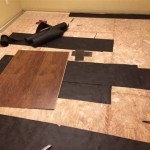How to Install Vinyl Flooring on Concrete Floor: A Comprehensive Guide
Vinyl flooring is a popular and versatile choice for both residential and commercial applications. Its durability, affordability, and ease of maintenance make it an ideal option for high-traffic areas. If you're considering installing vinyl flooring on your concrete floor, this comprehensive guide will provide you with the essential steps.
Materials you'll need:
- Vinyl flooring planks or tiles
- Underlayment (optional)
- Adhesive
- Notched trowel
- Level
- Measuring tape
- Utility knife
- Square or ruler
Step 1: Prepare the Concrete Floor
Begin by cleaning the concrete floor thoroughly to remove any dirt, debris, or grease. Use a degreaser and a mop or a power washer. Once the floor is clean, let it dry completely.
Check the level of the concrete floor using a level. Any uneven areas should be leveled using a self-leveling compound. Fill in any cracks or holes with a concrete patching compound.
Step 2: Install the Underlayment (Optional)
While not always necessary, an underlayment can provide additional insulation, soundproofing, and moisture protection. If you choose to use an underlayment, roll it out over the prepared concrete floor and secure it with tape or adhesive.
Step 3: Apply the Adhesive
Use a notched trowel to apply a thin layer of vinyl flooring adhesive to the concrete floor. The notch size should be appropriate for the type of flooring you are installing. Follow the manufacturer's instructions for the recommended coverage rate and adhesive drying time.
Step 4: Install the Vinyl Flooring Planks or Tiles
Starting from a corner of the room, press the first vinyl plank or tile into the adhesive. Use a level to ensure each plank is installed level and aligned correctly. Continue installing the planks or tiles row by row, making sure to stagger the joints.
Use a square or ruler to measure and mark cuts for the planks or tiles that fit around obstacles or walls. Use a utility knife to make precise cuts.
Step 5: Roll Out the Flooring
Once the vinyl flooring is installed, use a heavy roller to ensure it is fully adhered to the concrete floor. Roll over the entire surface, applying even pressure.
Step 6: Clean and Trim
Remove any excess adhesive or debris from the surface of the flooring using a damp cloth. If there are any exposed edges that need to be trimmed, use a sharp utility knife to cut them flush with the wall or other surfaces.
Step 7: Install Transition Strips (Optional)
If you are installing vinyl flooring in an area that transitions to another type of flooring, you may need to install transition strips to create a smooth and seamless finish. Transition strips can be made of metal, vinyl, or wood and are available in various styles to match your flooring.
Tips for a Successful Installation:
- Work in small sections to prevent the adhesive from drying prematurely.
- Keep a level handy to ensure the flooring is installed level throughout.
- Use a sharp utility knife to make precise cuts.
- Allow the flooring to cure according to the manufacturer's instructions before walking or placing furniture on it.
- Maintain the flooring regularly by sweeping, mopping, and using a vinyl flooring cleaner as needed.

How To Prepare A Concrete Floor For Vinyl Flooring Parrys

Easy Ways To Install Vinyl Plank Flooring On Concrete

Lvp Flooring Installation How To Install Luxury Vinyl Plank In A Basement Diy

Easy Ways To Install Vinyl Plank Flooring On Concrete

How To Install Vinyl Or Laminate Floors In A Basement Over Concrete Slab

Tips For Installing Vinyl Plank Over Concrete Floors Lemon Thistle

How To Install Vinyl Flooring On Concrete Floor Ers

Concrete Subfloor Preparation For The Vinyl Floor Installation How To Diy Mryoucandoityourself

Laminate Flooring On Concrete Basement Floors Expert Installation Guide Csg Renovation

Tips For Installing Vinyl Plank Over Concrete Floors Lemon Thistle
See Also







